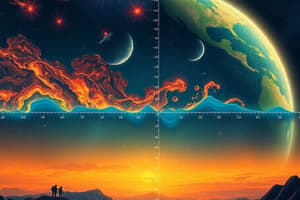Podcast
Questions and Answers
What is the largest division of the geological timescale?
What is the largest division of the geological timescale?
- Era
- Period
- Epoch
- Eon (correct)
What is characterized by significant geological or biological changes?
What is characterized by significant geological or biological changes?
- Era (correct)
- Eon
- Epoch
- Period
What geological event occurred approximately 4.5 billion years ago?
What geological event occurred approximately 4.5 billion years ago?
- Cambrian Explosion
- Formation of the Earth (correct)
- Oxygenation of the Atmosphere
- Mass Extinctions
What event occurred around 541 million years ago?
What event occurred around 541 million years ago?
What type of organisms emerged during the Paleocene Epoch?
What type of organisms emerged during the Paleocene Epoch?
How many known species of dinosaurs are there?
How many known species of dinosaurs are there?
Flashcards are hidden until you start studying
Study Notes
Geological Timescale
Divisions of the Geological Timescale
- Eon: The largest division of the geological timescale, with four eons: Hadean, Archean, Proterozoic, and Phanerozoic.
- Era: A division of an eon, with multiple eras within each eon. Eras are characterized by significant geological or biological changes.
- Period: A division of an era, with multiple periods within each era. Periods are characterized by specific rock formations or geological events.
Geological Events
- Formation of the Earth: Approximately 4.5 billion years ago, the Earth formed through the accretion of dust and gas in the solar nebula.
- Oxygenation of the Atmosphere: Around 2.7 billion years ago, oxygen-producing cyanobacteria emerged, changing the Earth's atmosphere.
- Mass Extinctions: Five major mass extinctions have occurred, with the most recent being the Cretaceous-Paleogene extinction event that wiped out the dinosaurs.
Animals in the Geological Record
- Early Life: The first life forms, such as single-celled organisms, emerged around 3.5 billion years ago.
- Cambrian Explosion: Around 541 million years ago, there was a rapid diversification of life forms, with the emergence of many animal phyla.
- Dinosaurs: Dominated Earth's landscapes during the Mesozoic Era (252-66 million years ago), with over 1,000 known species.
- Mammals: Emerged during the Paleocene Epoch (66-56 million years ago) and diversified during the Cenozoic Era.
Geological Timescale
Divisions of the Geological Timescale
- The largest division of the geological timescale is the Eon, with four eons: Hadean ( earliest phase of Earth's history), Archean ( ancient era), Proterozoic (era of slow change), and Phanerozoic (era of visible life).
- An Era is a division of an eon, characterized by significant geological or biological changes.
- A Period is a division of an era, characterized by specific rock formations or geological events.
Geological Events
- The Earth formed approximately 4.5 billion years ago through the accretion of dust and gas in the solar nebula.
- Oxygen-producing cyanobacteria emerged around 2.7 billion years ago, changing the Earth's atmosphere.
- There have been five major mass extinctions, with the most recent being the Cretaceous-Paleogene extinction event that wiped out the dinosaurs.
Animals in the Geological Record
- The first life forms, such as single-celled organisms, emerged around 3.5 billion years ago.
- The Cambrian Explosion, around 541 million years ago, was a rapid diversification of life forms, with the emergence of many animal phyla.
- Dinosaurs dominated Earth's landscapes during the Mesozoic Era (252-66 million years ago), with over 1,000 known species.
- Mammals emerged during the Paleocene Epoch (66-56 million years ago) and diversified during the Cenozoic Era.
Studying That Suits You
Use AI to generate personalized quizzes and flashcards to suit your learning preferences.




